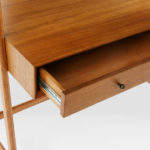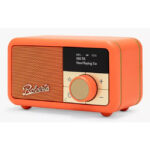
As I’m sure most readers already know, there’s a lot more to Manchester than the Arndale Centre. If you’ve been to the city in the last few months, and were near the Art Gallery, you might have noticed the image of a neatly dressed urbane European man, 3 button suited and his pipe at a jokey angle, friendly grin on his face, reclining on a plastic bodied, oval-padded throne. It’s not an image that tends to fit into the same compartment in your mind as ‘Art Gallery’, but if you passed it by, you missed one of the year’s top exhibitions!
This weekend, me and my other half decided to combine a visit to the city with a great night at the famous Hideaway Club, and an afternoon taking in a little design culture at the Joe Colombo exhibition. So it was a short hop on the train to Manchester Piccadilly, Friday evening relaxing over an Italian meal and some ruinously priced cocktails at our hotel, and (somehow) we managed to surface in time for the 10 o’clock opening of the exhibition the next day.
If you’re not familiar with the name, you may be familiar with Joe Colombo’s designs, which ranged from house and office furnishings and objects, many of which are still with us, made in tribute by others. Joe was a musician, architect and designer, working in his family business in Milan throughout the 50’s and 60’s. He designed many buildings and even plans for cities of the future, but it was his forward thinking designs for home wares the he is best remembered for. He seemed to obey the ‘form follows function’ school, in that everything he designed seemed shaped for precisely the purpose(s) it was intended for. His drinking glasses on single, side-mounted stalks enabled the user to hook the glass around the thumb, leaving the forefingers free to hold a cigarette. Needless to say, Joe enjoyed both of these activities, probably reclining on his tube-form furniture, literally a series of padded plastic tubes, stacked together to make chairs or sofas or even beds out of the simplest of forms. They could be taken apart and the smaller tubes stored inside the larger, when not needed. His radical space-age rooms were recreated in the gallery, or shown life-size on backlit photos, in beautiful vivid colours. A large TV set showed film of a trade ‘expo’ from our favourite decade, with young buyers wandering around the capsule-like but spacious rooms, all curved plastic walls, hidden cupboards and surfaces, and sliding or ‘concertina’ partitions. All of you Space 1999 fans will know what I’m describing.
The age we live in has made us used to the idea of furnishing a home from the bottom up, exactly as we’d like it, but to the young of the 60’s, often still living with their parents and sharing with brothers or sisters, or renting a bedsit with the landlord’s style stamped indelibly on it, this must have seemed like science fiction in itself, and a luxury only a few could afford. So while the successful actors, photographers etc. of the 60’s bought Joe’s Moonbase-like fantasy interiors, the no less stylish bought one of Joe’s smaller items, perhaps his D-shaped alarm clock that could be silenced by turning it on its side, to mod-up the bedside table.
His work desks, basically slabs of fibreboard covered in different shades of melamine and the corners rounded off, are still in use in many offices today, though probably through the thriftiness of the employers than any aesthetic considerations. Routed for telephone cables with recesses for pens, card indexes etc., they were something of a departure from the varnished wood and leather tops that had been in use in offices since the Victorian age.
Partitioning rooms held an excitement if you took Joe’s suggestion to your heart, that of a moveable wall with a swing compartment in the middle. On one side, a mirrored cocktail bar, on the other, a home entertainment centre, complete with TV, hi-fi and so on, all accessible with a push of your hand. The problem of space for storage was addressed by making revolving circular shelving, bought in a combination of shapes and sizes, to suit individual storage needs. Compartments for records (doesn’t that word sound so much better than ‘seedys’ – CDs), books (photographic, surely?), magazines (the best in Italian fashion, naturally!) anything. Some even hung from the ceiling, cranking up the spaceship look still further. Cupboards were similarly logical, modelled on travelling trunks, with the added convenience of lights and even a record player in one, the whole unit closeable and compact. Don’t call me anally retentive – I’m just tidy.
Joe had a keen eye for the future, but he never foresaw the advent of the personal computer, even though his cable-routed desks came in very handy when they made their way into our offices and homes. They don’t look as stylish as a bright red Olivetti typewriter, though, do they? The declining popularity of cigarette-smoking was something else he didn’t anticipate; almost every table, desk, cupboard and sofa he designed had a recessed ashtray in it. He died tragically young of a heart attack, aged just 41.
A fond farewell to an eye-popping exhibition, and don’t forget to look out for the book – wince when you read the price!
Scenester






